Supermicro SYS-110A-16C-RN10SP Internal Hardware Overview
Inside the system, we have the Supermicro A3SSV-16C-SPLN10F that we reviewed recently. At the same time, in a compact system like this, not all features of the motherboard are equally exposed.
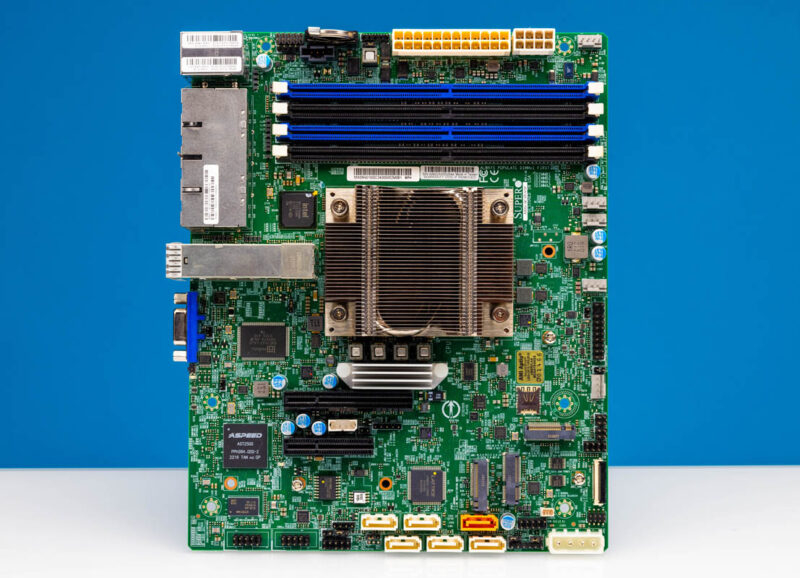
Inside the system, we can see that the system is packed.
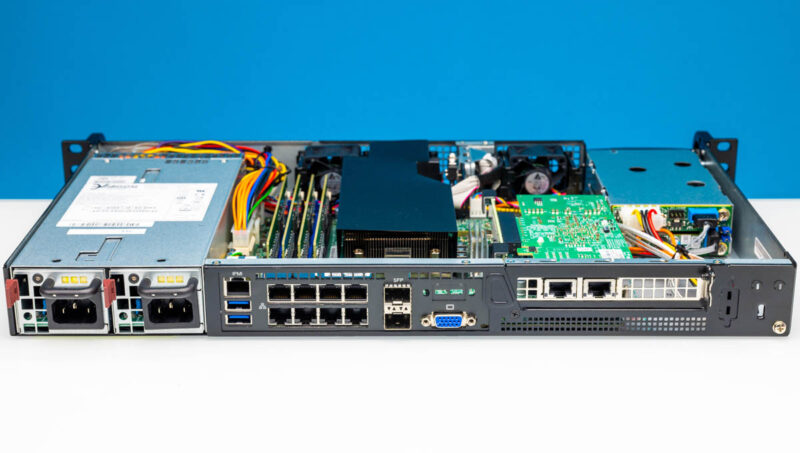
There is an airflow guide that services the CPU heatsink, which we wish was a hard plastic version. At the same time, a hard plastic version would be thicker which would mean a shorter heatsink and likely even more noise.
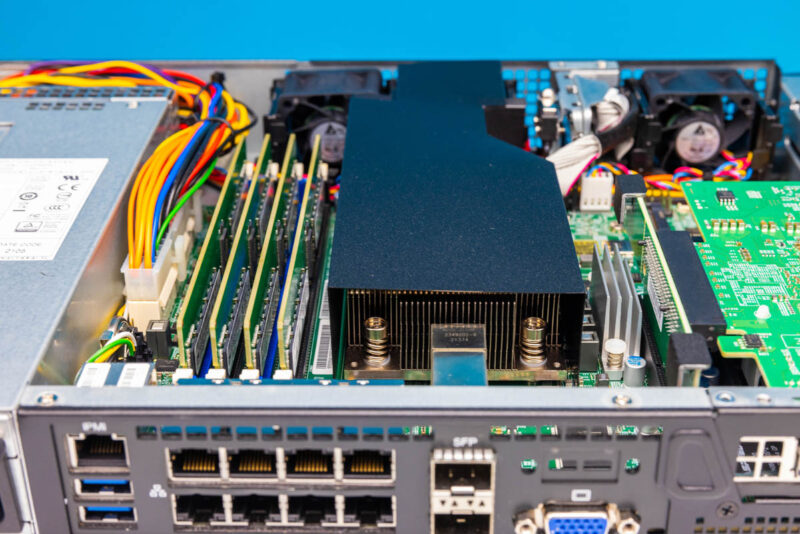
With that airflow guide removed, we can see the motherboard and the CPU heatsink.

Underneath the heatsink is an Intel Atom P5342, a 16 core “Snow Ridge” generation CPU that Intel designed for networking applications. This is a 10nm successor part to the popular Intel Atom C3000 “Denverton” series. With 16 E-cores and a built-in SoC with the PCH as well as 25GbE networking, this powers everything in the server.
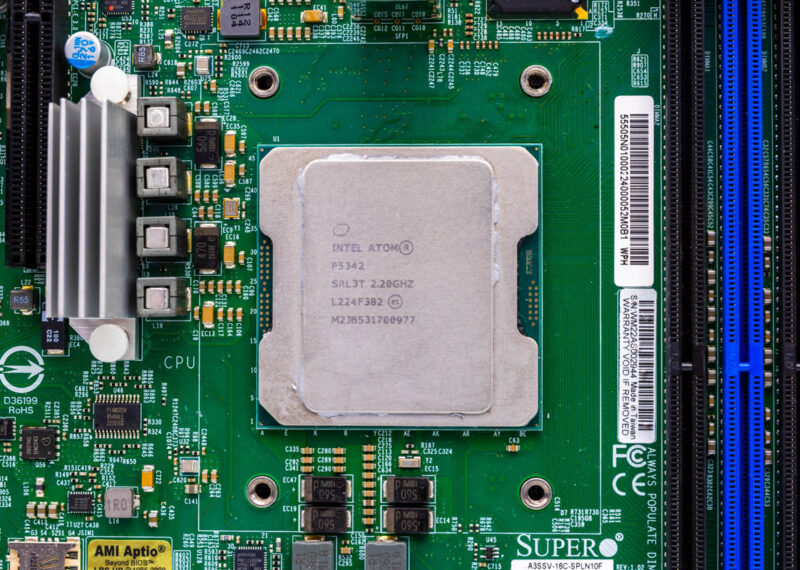
Next to the SoC, we get four DDR4 RDIMM slots. This system can take up to 4x 64GB RDIMMs for 256GB of memory.

On the motherboard, there are three M.2 slots that are M, B, and E-keyed for different types of expansion. We also get a gold powered SATADOM powered port and five more SATA ports onboard.

Those SATA ports are wired to the front 2x 2.5″ hot-swap drive bays.

Aside from the M.2 slots, we also see two PCIe Gen3 slots.

One of these is used for a PCie Gen3 x8 riser. We have the NIC installed to show something fun with this system. The rear faceplate is a full height bracket. At the same time, the physical space for the NIC is only a half-height half-length slot. Part of the reason is that it is so close to the SATA hot-swap bays inside.

There are only three chassis fans in this design, along with the power supply fans. As a result, these are going to be louder in this chassis since they will need to spin to cool the platform.

A small feature, but one that many older Supermicro designs from decades past lacked, is a chassis intrusion switch. We remember this was a feature absent on older Supermicro designs we reviewed from the early 2010s.
There is a lot crammed into this package, so let us next move to the system topology.

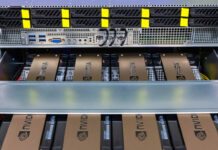
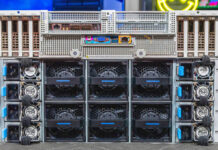

For storage use, how about install a PCIe 3.0 or higher SATA/SAS card in the riser slot, assuming it will fit. Use the onboard NMvE slots as the OS/cache drives.
If such a card has external connectors then you can connect to external storage chassis via appropriate cabling.
Init7 users in Switzerland will probably snap this up as it finally looks like a homelab type box that can route 25Gbs
Interesting they’re still using wires for all the power distribution. All the Dell servers I’ve seen for years now route power on the PCB itself, and the PSUs, fans and drive bays all slot into connectors directly on the motherboard so there’s no need to route any power cables through tight spaces.
Not that there’s anything wrong with using standard connectors, it just seems like it would require more manufacturing labour and thus increased cost.
I love reading about all the cool new hardware, but how much is this is this thing? I’m guessing in 2000 – 3000 dollar range – which waaay over a normal “serving the home” budget I think. I really think these high end products should be separated to another website or something, because so many or the articles (while cool) are not serving the home anymore.
@owen I belive Patrick has answered that question many times in the future, the serve the “home” part is now way in the past. I understand that thr name servethehome.com has a brand recognition thing attached to it and this is probably why they still use it, but I would have expected a rebrand of this website at this point in time to be honest. It would take some work but maybe they can refer to the old website name for a year or two while thr new rebranded name is getting traction.
The past. Not future:-)
Malvineous that’s why Supermicro has so many SKUs and Dell has so few. They’ve got one motherboard in many form factors with wired power inputs. They’ll even keep the same case for generations. FlexATX you can get C3000, P5000, D-1500, D-2100, and there’s older C2000 I’d think. Then you can use mITX in FlexATX cases too. It’s like 100 different motherboard SKUs that can be fit into the same chassis. If you’re selling these as an OEM appliance you can get the same look and make models with different perf levels.
Owen I’ve been reading STH for years. I don’t understand that comment at all. They do lots of inexpensive gear. Lots of very expensive gear. I’d wager most here have homelabs because we use servers at work. That work gear in 2-3 years becomes homelab gear.
This is also a machine that homes with high-end internet like Korev is mentioning can use. If you’re in silicon valley there’s people spending $11,000 USD for 1m^2 on homes not even in the nicer areas or downtown San Francisco. If they’ve got fiber at a few hundred a month because US broadband prices are very high, then a $2000 machine as a firewall is not even a year’s worth of broadband service.
I’d also understand if you’re coming from a place like Albania, Rawanda, Alabama, Argentina homes are cheap, but then they’re covering cheap gear too that’s more applicable. Homes aren’t just in those cheap places.
Owen the barebones cost is $1800 retail for this edge server. By no means is that high end. If you go and get a Cisco 4200 series firewall (only the 9000 series is above that by them) you are looking at $200,000 or more for one device. For a home this would be high end but that’s it.
@owen, I believe due to the nature of readers here, it serves home IT professionals. For many, this price suffices for homelab, small business and high end home clients. I will probably end up buying a D-1700 series myself….
For provisioning a homelab, it would be interesting what the minimum spend would be for a system that can effectively route 25 gigabit Ethernet. A further study on the effects of firewall rules and operating systems at that level of performance would also be useful.
The pictures and measured time to build a Python interpreter from source are also nice.
How does a Raspberry Pi with a 2.5 gigabit USB Ethernet dongle compare? What about those router style mini PCs with multiple built-in Ethernet ports? How does increasing the complexity of the firewall rules affect these cheaper solutions?
@Owen has a reasonable point, in that this is not what most would think of as a home server; however some of my friends do have racks in their basement, and for many the office has migrated to the home as well.
Personally I’m still satisfied with the HP MicroServer Gen 8 that I got for <£200 shipped, and upgraded to 12GB RAM and an i5-3470T once it was cheaper to do so. But I find this site useful for reviews of equipment I may lease in 3-6 years' time, or possibly get second-hand.
As for a new name, may I suggest ServeTheOffice?
You know, it’d be interesting to see a series on 10+ Gbps office/lab/home routing options with performance tests. What can you really push through a Snow Ridge CPU running pfsense? What about VyOS? TNSR? How do N100s/Xeon D/Ryzen 7xxx CPUs compare?
I’m seeing it just today and felt that missing opportunity on design, if they rotated 180° the board facing all the back ports at the front (only redundant power at the back) that could have been a pretty cool all around 1U rackable multirole appliance, and with a couple of 2.5″ U.2 compatible bays, oooofff.
Eric Olson: For provisioning a homelab, it would be interesting what the minimum spend would be for a system that can effectively route 25 gigabit Ethernet.
See https://michael.stapelberg.ch/posts/2021-07-10-linux-25gbit-internet-router-pc-build/ for a good example – there are other interesting 25Gb internet posts there too
I love these short-depth supermicro servers. I’ve got a stack of them.
Those air shrouds are always mylar in this supermicro form factor. I don’t mind it. I’ve even copied the approach to make my own shrouds when building short-depth 1U servers.
@Scott Laird: I think this is brilliant idea. Seeing how these e-cores, p-cores etc. and even older “TinyMiniMicro” devices translate into real world networking performance.